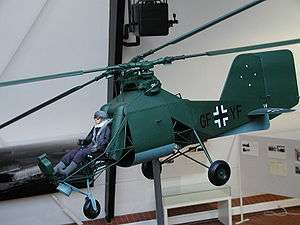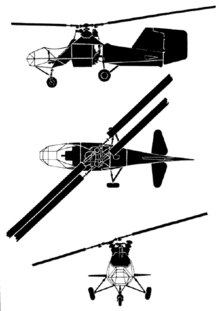Flettner Fl 282
| Fl 282 Kolibri | |
|---|---|
 | |
| Flettner Fl 282 during flight trials after World War II, with US markings. | |
| Role | Helicopter |
| Manufacturer | Anton Flettner, Flugzeugbau GmbH |
| First flight | 1941 |
| Introduction | 1942 |
| Retired | 1945 |
| Primary user | Luftwaffe |
| Number built | 24 |
The Flettner Fl 282 Kolibri ("Hummingbird") is a single-seat intermeshing rotor helicopter, or synchropter, produced by Anton Flettner of Germany. According to Yves Le Bec, the Flettner Fl 282 was the world's first series production helicopter.[1]
Design and development
The Fl 282 Kolibri was an improved version of the Flettner Fl 265 announced in July 1940, which pioneered the same intermeshing rotor configuration that the Kolibri used. It had a 7.7 litre displacement, seven-cylinder Siemens-Halske Sh 14 radial engine of 150-160 hp mounted in the center of the fuselage, with a transmission mounted on the front of the engine from which a drive shaft ran to an upper gearbox, which then split the power to a pair of opposite-rotation drive shafts to turn the rotors.[2]
The Sh 14 engine was a tried-and-true design that only required servicing every 400 hours, as opposed to the nearly 27 litre displacement, nine-cylinder BMW/Bramo Fafnir 750 hp radial engine powering the larger Focke Achgelis Fa 223 helicopter, whose outdated design required maintenance every 25 hours. The Fl 282's fuselage was constructed from steel tube covered with doped fabric, and it was fitted with a fixed tricycle undercarriage.
The German Navy was impressed with the Kolibri and wanted to evaluate it for submarine spotting duties, ordering an initial 15 examples, to be followed by 30 production models. Flight testing of the first two prototypes was carried out through 1941, including repeated takeoffs and landings from a pad mounted on the German cruiser Köln.
The first two "A" series prototypes had enclosed cockpits; all subsequent examples had open cockpits and were designated "B" series.
In case of an engine failure, the switch from helicopter to autorotation was automatic.[3][4]
Three-bladed rotors were installed on a test bed and found smoother than the vibrating 2-blade rotor, but the concept was not pursued further.[4] The hover efficiency ("Figure of Merit") was 0.72[5] whereas for modern helicopters it is around 60%.[6]
Intermeshing rotors were not used on a mass production helicopter until after World War Two.
Operational history

Intended roles of Fl 282 included ferrying items between ships and reconnaissance. However, as the war progressed, the Luftwaffe began considering converting the Fl 282 for battlefield use. Until this time the craft had been flown by a single pilot, but by then a position for an observer was added at the very rear of the craft, resulting in the B-2 version.[7] Later the B-2 proved a useful artillery spotting aircraft and an observation unit was established in 1945 comprising three Fl 282 and three Fa 223 helicopters.[8]
Good handling in bad weather led the German Air Ministry to issue a contract in 1944 to BMW to produce 1,000 units. However, the company's Munich plant was destroyed by Allied bombing raids after producing just 24 machines.[9]
Towards the end of World War II most of the surviving Fl 282s were stationed at Rangsdorf, in their role as artillery spotters, but gradually fell victim to Soviet fighters and anti-aircraft fire.
Variants
- Fl 282 V1/7
- Prototypes.
- Fl 282A-1
- Single-seat naval reconnaissance type, for operation from cruisers and other warships. Tested in the Baltic, Mediterranean and Aegean Seas.
- Fl 282A-2
- Single-seat reconnaissance type for submarines equipped with special deck hangar, project only.
- Fl 282B-1/B-2
- Two-seat land reconnaissance-liaison helicopter
Operators
Surviving aircraft
- A single Fl 282 was captured at Rangsdorf by Soviet forces
- Two, which had been assigned to Transportstaffel 40 (TS/40) — the Luftwaffe's only operational helicopter squadron — at Mühldorf, Bavaria, were captured by U.S. forces.[8]
- Fl 282 V-10 28368 Midland Air Museum, Coventry, England. Partial aircraft, frame with rotor head & wheels.
- Fl 282 V-23 was at one time to be found at the National Museum of the United States Air Force, Dayton, Ohio.[10]
Specifications (Fl 282 V21)

Data from [11]
General characteristics
- Crew: 1
- Length: 6.56 m (21 ft 6 in)
- Height: 2.2 m (7 ft 3 in)
- Empty weight: 760 kg (1,676 lb)
- Max takeoff weight: 1,000 kg (2,205 lb)
- Powerplant: 1 × Bramo Sh.14A 7-cyl. air-cooled radial piston engine, 119 kW (160 hp)
- Main rotor diameter: 2× 11.96 m (39 ft 3 in)
- Main rotor area: 224.69 m2 (2,418.5 sq ft)
Performance
- Maximum speed: 150 km/h (93 mph; 81 kn) at sea level
- Range: 170 km (106 mi; 92 nmi)
- Service ceiling: 3,300 m (10,800 ft)
- Hover ceiling: 300 m (984 ft)
- Rate of climb: 1.52 m/s (299 ft/min)
- Rotor loading: 8.84 kg/m2 (1.81 lb/sqft)
See also
Related development
Aircraft of comparable role, configuration and era
References
- Notes
- ↑ Le Bec, Yves. La véritable histoire de l'hélicoptère: De 1486 à 2005 (French). Grossfeldstrasse, Switzerland: Hélico revue, 2005. ISBN 978-2-8399-0100-0.
- ↑ Ford, Roger (2013). Germany's Secret Weapons of World War II. London, United Kingdom: Amber Books. p. 224. ISBN 9781909160569.
- ↑ Smith and Kay 1978, p. 596.
- 1 2 Lang, Gerhard. Flettner Fl 282 (The Luftwaffe Profile Series , No 6). Atglen, Pennsylvania: Schiffer Publishing, 1996. ISBN 0-88740-921-0.
- ↑ Jackson, Dave. "Figure of Merit" Unicopter, 16 December 2011. Retrieved: 22 May 2015. Archived on 26 November 2013.
- ↑ Whittle, Richard. "It’s A Bird! It’s A Plane! No, It’s Aircraft That Fly Like A Bird!" Breaking Defense, 12 January 2015. Retrieved: 17 January 2015. Archived on 1 May 2015.
- ↑ Jackson 2005, p. 110.
- 1 2 Hyland, Gary. Last Talons of the Eagle: Secret Nazi Technology Which Could Have Changed the Course of World War II. North Pomfret, Vermont: Trafalgar Square Publishing, 1999. ISBN 0-7472-5964-X.
- ↑ Donald 1997.
- ↑ Smith, J.R.; Anthony L. Kay (1990). German Aircraft of the Second World War (2nd ed.). London: Putnam & Company Ltd. p. 595. ISBN 0-370-00024-2.
- ↑ Green, William (2010). Aircraft of the Third Reich. Vol.1 (1st ed.). London: Aerospace Publishing Limited. pp. 328–329. ISBN 978-1-900732-06-2.
- Bibliography
- Coates, Steve and Jean-Christophe Carbonel. Helicopters of the Third Reich. Crowborough, UK: Classic Publications Ltd., 2002. ISBN 1-903223-24-5.
- Donald, David, ed. The Complete Encyclopedia of World Aircraft. New York: Barnes & Noble Books, 1997. ISBN 0-7607-0592-5.
- Jackson, Robert, ed. "Flettner FL 282 Kolibri." Helicopters: Military, Civilian, and Rescue Rotorcraft (The Aviation Factfile). London: Grange Books Ltd, 2005. ISBN 1-84013-812-2.
- Nowarra, Heinz J. German Helicopters, 1928-1945. Atglen, Pennsylvania: Schiffer Publishing, 1990. ISBN 0-88740-289-5.
- Smith, J.R.; Anthony L. Kay (1990). German Aircraft of the Second World War (2nd ed.). London: Putnam & Company Ltd. ISBN 0-370-00024-2.
- Witkowski, Ryszard. Rotorcraft of the Third Reich. Redbourn, UK: Mushroom Model Publications, 2007. ISBN 978-83-89450-43-2.
External links
| Wikimedia Commons has media related to Flettner Fl 282. |